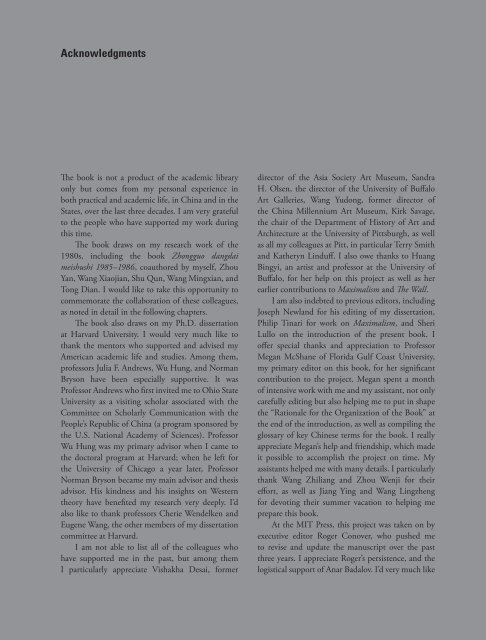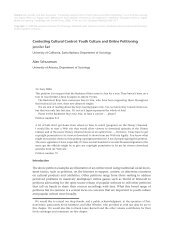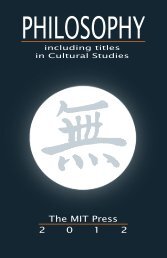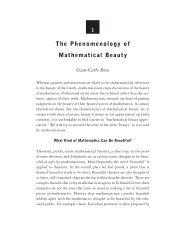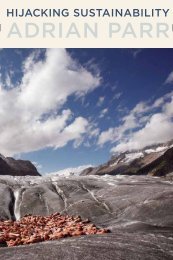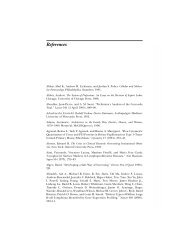Sample Chapter - Download PDF - MIT
Sample Chapter - Download PDF - MIT
Sample Chapter - Download PDF - MIT
You also want an ePaper? Increase the reach of your titles
YUMPU automatically turns print PDFs into web optimized ePapers that Google loves.
Acknowledgments<br />
The book is not a product of the academic library<br />
only but comes from my personal experience in<br />
both practical and academic life, in China and in the<br />
States, over the last three decades. I am very grateful<br />
to the people who have supported my work during<br />
this time.<br />
The book draws on my research work of the<br />
1980s, including the book Zhongguo dangdai<br />
meishushi 1985–1986, coauthored by myself, Zhou<br />
Yan, Wang Xiaojian, Shu Qun, Wang Mingxian, and<br />
Tong Dian. I would like to take this opportunity to<br />
commemorate the collaboration of these colleagues,<br />
as noted in detail in the following chapters.<br />
The book also draws on my Ph.D. dissertation<br />
at Harvard University. I would very much like to<br />
thank the mentors who supported and advised my<br />
American academic life and studies. Among them,<br />
professors Julia F. Andrews, Wu Hung, and Norman<br />
Bryson have been especially supportive. It was<br />
Professor Andrews who first invited me to Ohio State<br />
University as a visiting scholar associated with the<br />
Committee on Scholarly Communication with the<br />
People’s Republic of China (a program sponsored by<br />
the U.S. National Academy of Sciences). Professor<br />
Wu Hung was my primary advisor when I came to<br />
the doctoral program at Harvard; when he left for<br />
the University of Chicago a year later, Professor<br />
Norman Bryson became my main advisor and thesis<br />
advisor. His kindness and his insights on Western<br />
theory have benefited my research very deeply. I’d<br />
also like to thank professors Cherie Wendelken and<br />
Eugene Wang, the other members of my dissertation<br />
committee at Harvard.<br />
I am not able to list all of the colleagues who<br />
have supported me in the past, but among them<br />
I particularly appreciate Vishakha Desai, former<br />
director of the Asia Society Art Museum, Sandra<br />
H. Olsen, the director of the University of Buffalo<br />
Art Galleries, Wang Yudong, former director of<br />
the China Millennium Art Museum, Kirk Savage,<br />
the chair of the Department of History of Art and<br />
Architecture at the University of Pittsburgh, as well<br />
as all my colleagues at Pitt, in particular Terry Smith<br />
and Katheryn Linduff. I also owe thanks to Huang<br />
Bingyi, an artist and professor at the University of<br />
Buffalo, for her help on this project as well as her<br />
earlier contributions to Maximalism and The Wall.<br />
I am also indebted to previous editors, including<br />
Joseph Newland for his editing of my dissertation,<br />
Philip Tinari for work on Maximalism, and Sheri<br />
Lullo on the introduction of the present book. I<br />
offer special thanks and appreciation to Professor<br />
Megan McShane of Florida Gulf Coast University,<br />
my primary editor on this book, for her significant<br />
contribution to the project. Megan spent a month<br />
of intensive work with me and my assistant, not only<br />
carefully editing but also helping me to put in shape<br />
the “Rationale for the Organization of the Book” at<br />
the end of the introduction, as well as compiling the<br />
glossary of key Chinese terms for the book. I really<br />
appreciate Megan’s help and friendship, which made<br />
it possible to accomplish the project on time. My<br />
assistants helped me with many details. I particularly<br />
thank Wang Zhiliang and Zhou Wenji for their<br />
effort, as well as Jiang Ying and Wang Lingzheng<br />
for devoting their summer vacation to helping me<br />
prepare this book.<br />
At the <strong>MIT</strong> Press, this project was taken on by<br />
executive editor Roger Conover, who pushed me<br />
to revise and update the manuscript over the past<br />
three years. I appreciate Roger’s persistence, and the<br />
logistical support of Anar Badalov. I’d very much like<br />
Acknowledgments ix
to thank the editorial, design, and production team<br />
at the Press, including Matthew Abbate and Jessica<br />
Niles DeHoff for their hard work on the long process<br />
of editing the work, as well as Yasuyo Iguchi for her<br />
design talents.<br />
I really appreciate the strong support of the<br />
artists who have sent me firsthand materials from<br />
their work year by year through the last three<br />
decades. This has not only helped to establish my<br />
personal archive of Chinese contemporary art, but<br />
in particular has made this highly illustrated book<br />
possible. The images and materials from the book as<br />
well as from my archive bring many good memories<br />
of exciting communication between myself and the<br />
artists, either in person or by mail.<br />
Finally, I am deeply grateful to Pearl Lam, the<br />
chair of the China Art Foundation, and to Susan<br />
Hayden, and Philip Dodd, members of the board<br />
of the Foundation, for their friendship and their<br />
support of this project.<br />
Gao Minglu<br />
x Acknowledgments


